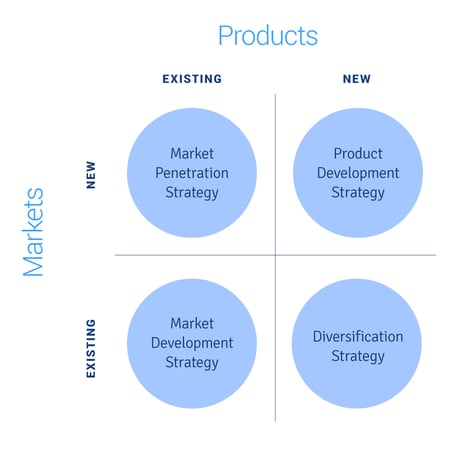Did you start a brand to see it lose momentum or market share to competitors?
It’s a silly question to ask owners yet a number of brands make mistakes within their chosen market. At times, it’s not a matter of what you’re doing but what a brand is not doing that impedes opportunity for growth. That’s where market penetration strategies come to play.
What’s a common characteristic of powerful brands? They increase market share and continue to seize opportunity. But, realizing business success requires a continual growth strategy.
In this guide, you’ll learn how to:
- Gain a better understanding of market penetration strategies
- Read market penetration examples
- Get tips regarding the best marketing penetration strategies
What Is Market Penetration?
Market Penetration Definition
The term market penetration adopts a theoretical and literal meaning. On one hand, a brand calculates market penetration to gain a sense of the size of a market and what percentage of consumers buy its products and services within. In the literal sense, market penetration is the actions taken to overtake competitors and gain a larger share of the market.
Market penetration is the percentage of products/services sold in relation to the estimated total market. Theoretically, a brand wants to eliminate all competition, completely owning all the market share for a given product or service. Calculating the entire market size and estimating how much of the pie you own is incredibly useful for new and established brands.
Market Penetration Rate
A simple equation related to market penetration:
(Number of customers/Size of market) x 100 = Market Penetration Rate
For example, assume 500 million people live in a country, and 100 million of them own an iPhone.
100/500 x 100 = 20% penetration rate
So, the market penetration for iPhones would be 20%. Theoretically, 400 million people or the remaining 80% of the population remains for the taking.
An above average market penetration rate for consumer goods is estimated to be between 2% and 6%. A good penetration rate for business products is between 10% and 40%.
Some brands calculate market penetration every quarter while others find it useful to do so after each ad and marketing campaign.
High Market Penetration
As you can imagine, most brands aspire to an above average or good rate market penetration rate. Having a high penetration rate reaps immediate monetary benefits.
In 2018, Amazon’s share of the US ecommerce market was 49% - more than its top three competitors combined! To put it another way, Amazon accounts for 5% of all retail dollars spent throughout the entire United States.
In the same year, iPhones captured an estimated 15% to 20% market penetration rate. Apple sold 77.3 million iPhones, finishing the December quarter with a 19.2% share.
A brand with high market penetration enjoys immediate riches as well as an ongoing reputation it can continue to leverage. However, the real advantage is enjoying the forward and upward momentum built. Another benefit is that you’re able to set the prices that your competitors follow, rather than you having to follow others.
Market Penetration vs Market Share
Market penetration is a percentage of a given target market that buys a brand’s products/services. It is distinguishable from market share, which is the portion of total value of a market captured by a brand.
Market Penetration Examples
Market penetration begins with strategy, yet when applied, leads to actionable steps that achieve stable market dominance.
Apple reached a market share of more than 50% of the world market with its smartphones by 2017. Since the inception of the iPhone, Apple consistently released upgrades, enhancements, and accessories. As a result of this market penetration, Apple feasts on a larger market share than all its competitors combined.
Dunkin’ started in the 1940s in Massachusetts. Today, the brand formerly known as Dunkin’ Donuts is found in 46 countries. However, its most loyal following remain in New England, for one-third of all Dunkin’ stores reside there.
The Coca-Cola brand established itself as a beverage associated with snacks, enjoying the benefits of the refreshment market until tastes began changing in preference of healthier choices. Coke offered Diet Coke to gain a larger share of the beverage market, capturing those more health minded. When market research revealed more women than men preferred Diet Coke, the brand initiated Coke Zero as a ‘catchall’ solution.
Best Market Penetration Strategies
The actionable part of a market penetration definition relates to actual strategies. Market penetration strategies allow a brand to take its existing product or service to an already thriving market with high demand and begin drawing-in a larger share of the entire market, eventually draining competitors of opportunity and money.
Market penetration (as a set of actions) is taken from Igor Ansoff, creator of the Ansoff Matrix. The grid features four growth strategies related to entering a new or existing market with new or established products/services.

Get in touch with our pricing consultants to find out more about pricing strategies for your business.

1 - Use Dynamic Pricing
Many online retailers engage in price wars in an attempt to persuade customers to buy products and services at the best price. The market penetration strategy grows more intense and complicated given online prices rise and drop throughout any given day.
Dynamic pricing allows for pricing automation, so regardless of the size or complexity of given products/services, the associated software researches the market and sets prices to deliver actionable intelligence.
Further Reading: Why Price Is the Most Important P in the Marketing Mix
2 - Add Distribution Channels
Adding distribution channels is another market penetration strategy focused on growth. For example, if a brand solely leverages retail outlets, it may benefit from considering adding other ones such as email marketing, online marketing, and telemarketing.
3 - Target Specific Locations
Some products and services are seasonal while others have a greater demand depending on location (A sunscreen brand targeting sunny Los Angeles versus rainy Seattle). Targeting the location in need would lead to a surge in use and increase in sales in that region.
4 - Improve Products
If a brand can trace market share to a particular product or service then it would make sense to consider improving upon what the public already likes. Understanding what consumers like (or even better, dislike) about a product presents an opportunity to make it even more loved and preferred depending on technology related to materials, newly developed accessories, etc.
5 - Enter New Geographical Markets
The ever-growing spending within the Latin American market has intrigued many brands to expand offerings to Mexican and other Latin American locales. Making the opportunity for growth more a reality, many brands hire Spanish translation services to ensure brand offerings are in Spanish, but also effectively resonate with the Latin American peoples and their culture.
A great example of this is when CNET entered the Hispanic market with zeal by partnering with Latin World Entertainment in addition to recruiting well-recognized superstar Sophia Vergara.
6 - Create a Barrier to Entry
Wise brands create barriers to entry for competitors by utilizing existing resources or seeking those that would either make a product or service superior or allow to offer such at an unbeatable cost.
For example, a food supplier dependent on several farms for production may cut overall costs by investing in its own farm versus buying needed goods from a third party. Amazon continuously reinvests in its customer service, features, and ability to penetrate the market, making it nearly impossible for another online platform to compete.
Further Reading: The Complete Guide to Selling on Amazon
7 - Change a Design
Water is essential to human life, but only in the last century that it has been offered in plastic bottles. Wine is another example of a beverage that has been around for centuries, yet offering it in a box versus a bottle is a very contemporary market penetration strategy.
8 - Make It Easier to Buy
How seamless is your online checkout process? Do you have an online checkout process? Making it easier to find and buy your goods and services is a surefire way to penetrate a greater share of a targeted market.
9 - Create and Recruit Established Advocates
Word-of-mouth remains a stellar way to spread word and garner more advocates. Many brands offer membership and/or referral programs. Advocates create support by actively recruiting friends and family, helping the brand penetrate a larger share of the market and make more money.
Amazon creates its own internal “club” via Amazon Prime subscription. 26 Amazon Prime Day stats reveals 100 million US shoppers have an Amazon Prime subscription (62% of Amazon’s customer base in the United States)!
10 - Educate the Market
For a newer brand entering an established market, the challenge is not creating a want, for it’s already established. The real hurdle is educating the market about a new choice or selection and drawing attention away from brands that already exist.
Cabot, makers of cheese, use Pinterest and a variety of social media tools to educate the market on grilled cheese recipes, farms and farmers in their ‘family’ of production, New England ski spots, and healthy options for those who are lactose intolerant.
Final Thoughts
Ecommerce retailers don’t need to reinvent the wheel regarding the marketing channel. In 2021, it’s more than well established that the opportunity to offer products and services online is there. However, how can e-tailers compete with large competitors such as Amazon? The answer is better understanding market penetration and developing the best marketing penetration strategies to gain a larger share of a targeted market.
Curious to learn about some other pricing strategies? Check out some of our other articles below.
- What is Value Based Pricing?: A full overview of how price and consumer perception work together.
- What is Charm Pricing?: A short introduction to a fun pricing method
- What is Penetration Pricing?: A guide on how to get noticed when first entering a new market
- What is Odd Even Pricing?: An explanation of the psychology behind different numbers in a price.
- What is Bundle Pricing?: Learn more about the benefits of a bundle pricing strategy
- What is Cost Plus Pricing?: In this article, we’ll cover cost-plus pricing and show you when it makes sense to use this strategy.
- What is Map Pricing?: Review our educational tool giving you a broad understanding of MAPs.
- Here’s What You Need to Know About Psychological Pricing (Plus 3 Strategies to Help You Succeed): Modern day pricing is so much more than a numbers game. When thought about correctly, it’s a powerful way to build your brand and drive more profits.
- How to Build a Pricing Strategy: A complete guide on how to build a pricing strategy from Omnia partner Johan Maessen, owner of Commercieel Verbeteren.




